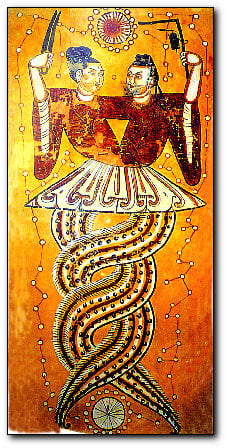Fu Xi
In Chinese mythology, Fu Xi or Fu Hsi (Chinese: 伏羲; pinyin: fúxī; aka Paoxi (Simplified Chinese: 庖牺; Traditional Chinese: 庖犧; pinyin: páoxī)), mid 2800s B.C.E., was the first of the mythical Three Sovereigns (三皇 sānhuáng) of ancient China. He is a culture hero reputed to be the inventor of writing, fishing, and trapping.
Biography
Fu Xi was born on the lower-middle reaches of the Yellow River in a place called Chengji (possibly modern Lantian, Shaanxi or Tianshui, Gansu).[1]
According to legend the land was swept by a great flood and only Fuxi and his sister Nüwa survived. The retired to Kunlun Mountain where they prayed for a sign from the Emperor of Heaven. The divine being approved their union and the siblings set about procreating the human race.[1] Fu Xi then came to rule over his decedents although reports of his long reign vary between sources from 115 years (BCE 2852-2737) to 116 years (BCE 2952-2836).
He lived for 197 years altogether and died at a place called Chen (modern Huaiyang, Henan) where his mausoleum can still be found.[1]
Social importance
Among the three primogenitors of Hua-Xia civilization, Fu Xi in Huaiyang Country ranks first.
Couplet engraved on column of Fu Xi Temple, Huaiyang Country, Henan Province[1]
During the time of his predecessor Nüwa (who according to some sources was also his wife and/or sister) society was matriarchal and primitive. Childbirth was seen to be miraculous not requiring the participation of the male and children only knew their mothers. As the reproductive process became better understood ancient Chinese society moved towards a patriarchal system and Fu Xi assumed primary importance.[1]
In the beginning there was as yet no moral or social order. Men knew their mothers only, not their fathers. When hungry, they searched for food; when satisfied, they threw away the remnants. They devoured their food hide and hair, drank the blood, and clad themselves in skins and rushes. Then came Fu Hsi and looked upward and contemplated the images in the heavens, and looked downward and contemplated the occurrences on earth. He united man and wife, regulated the five stages of change, and laid down the laws of humanity. He devised the eight trigrams, in order to gain mastery over the world.
Ban Gu, Baihu tongyi[2]
Fu Hsi taught his subjects to cook, to fish with nets, and to hunt with weapons made of iron. He instituted marriage and offered the first open air sacrifices to heaven. A stone tablet, dated 160 C.E. shows Fu Hsi with Nüwa, who was both his wife and his sister.
Traditionally, Fu Hsi is considered the originator of the I Ching (also known as the Yi Jing or Zhou Yi), which work is attributed to his reading of the He Map (or the Yellow River Map). By this tradition, Fu Hsi had the arrangement of the trigrams (八卦 bāgùa) of the I Ching revealed to him supernaturally. This arrangement precedes the compilation of the I Ching during the Zhou dynasty. Fu Hsi is said to have discovered the arrangement in markings on the back of a mythical dragon-horse (sometimes said to be a turtle) that emerged from the river Luo. This discovery is also said to have been the origin of calligraphy.
Fu Hsi is also credited with the invention of the Guqin, together with Shennong and Huang Di.
Contemporary references to Fu Hsi
Fu Xi made an appearance in the second part of Hong Kong television series My Date with a Vampire 3. In it, he is also called Ren Wang, or the King of Humanity, with a magical bow and arrow as his weapons. He was sent down from heaven and it is on him whom Nüwa based her creation, humanity. Within the show Nüwa and Fuxi are not married.
Fu Xi and his wife/sister Nüwa appear as unlockable characters in the video game Dynasty Warriors 3.
Fu Xi is featured in the "Conversation on Information Technology over 5000 Years" sculptural panels at the Norwalk Community College Center for Information Technology, near New Haven, Connecticut. They were sculpted by the facility's architect, Barry Svigals.
See also
Sources, references, external links, quotations
| Three Sovereigns and Five Emperors | ||
|---|---|---|
| Preceded by: Suiren |
Emperor of China c 2800 B.C.E. – 2737 B.C.E. |
Succeeded by: Shennong |
| Persondata | |
|---|---|
| NAME | Fu Xi |
| ALTERNATIVE NAMES | Fu Hsi |
| SHORT DESCRIPTION | |
| DATE OF BIRTH | |
| PLACE OF BIRTH | |
| DATE OF DEATH | |
| PLACE OF DEATH | |
ru-sib:Фу Си sh:Fu Hsi
Credits
New World Encyclopedia writers and editors rewrote and completed the Wikipedia article in accordance with New World Encyclopedia standards. This article abides by terms of the Creative Commons CC-by-sa 3.0 License (CC-by-sa), which may be used and disseminated with proper attribution. Credit is due under the terms of this license that can reference both the New World Encyclopedia contributors and the selfless volunteer contributors of the Wikimedia Foundation. To cite this article click here for a list of acceptable citing formats.The history of earlier contributions by wikipedians is accessible to researchers here:
The history of this article since it was imported to New World Encyclopedia:
Note: Some restrictions may apply to use of individual images which are separately licensed.
